11.5" x 11.5" Unsealed Regular Saltillo Square Edges - Floor Tile
Saltillo Floor Tile
This item will ship by freight truck.
Sample orders will be shipped with one of the other carriers.
Please call for 1 free sample. Shipping charges apply. Samples may not be full pieces.
All pricing is per tile.
- Description
- Specs
- Reviews
You may order samples online. Sample must be purchased and shipping charges apply. Please keep in mind sample tiles may vary in color from future orders due to the handmade process.
Saltillo tiles are NOT frost resistant, they should not be used on outdoor installations with potential freezing temperatures.
PLEASE CONSIDER: The Saltillo is unique, irregular, functional and expressive. Saltillo tiles vary in texture, Not perfectly flat, they have chipped edges, craters, and from time to time you may run into tiles with animal tracks. A high percentage of the batches of Saltillo tiles are subject to "lime pops". Craters or lime pops are caused by alkaline deposits, these are usually inhibited and may be stopped by sealing the tile with a penetrating sealer. Sealers penetrate into the lime pocket, demystifying it, keeping water out and therefore preventing the lime pop.
Substantial variations are expected for all Saltillo tiles. Size, random color and texture differences will be present from piece to piece. Final installation will be unique. Therefore, it is recommended that the entire range is viewed and arranged before installation.
The Making of Saltillo - Mexican Pavers
The name of Saltillo in Saltillo tiles is derived from the city of Saltillo, Coahuila in Mexico. Saltillo is renown for its abundant natural resource of clay. This clay is particularly suitable to make Saltillo tile and is only found only in this region of Mexico.
The Saltillo clay has been used for centuries to make Saltillo tiles, it is greatly appreciated by those who like the ambience of warm of Mexican hacienda style, Mediterranean style, or California style homes.
The process of creating Saltillo tiles is similar to the old-world tradition of making tiles by hand; which is preserved and continues to this day in Saltillo. The unique clay and the process gives Saltillo tile a unique, random, natural look which is what makes Saltillo tiles so popular.
Raw Saltillo tiles can appear rather plain, but after installation, grouting, and sealing they are very attractive, easy to maintain and will virtually last forever.
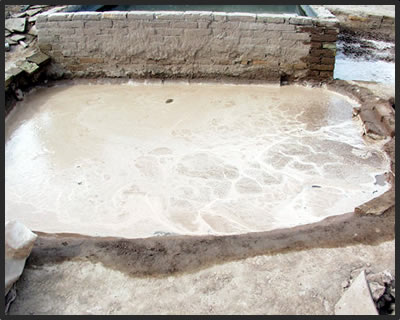 |
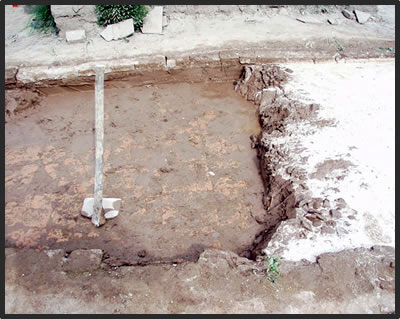 |
The clay is extracted from mines that are nearby the hills of Saltillo, Coahuila. Once the clay has been extracted and consolidated in wells it is soaked in water. |
The clay is left soaking in water overnight before it is ready to be transformed into beautiful rustic handcrafted Saltillo floor tiles. |
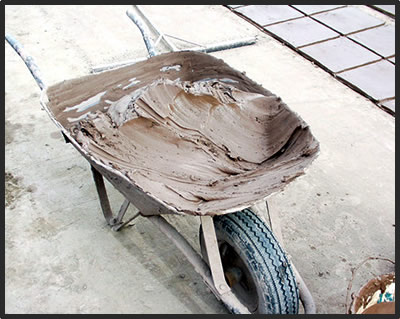 |
 |
A cart wheel is used to bring the Saltillo clay to a working area where it will be transformed into a Saltillo tile bisque. |
Artisans bring some of the clay from clay pool. And make each tile by hand. The artisan makes tiles in sucession and fills rows and rows of handcrafted Saltillo floor tiles. |
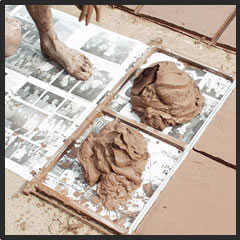 |
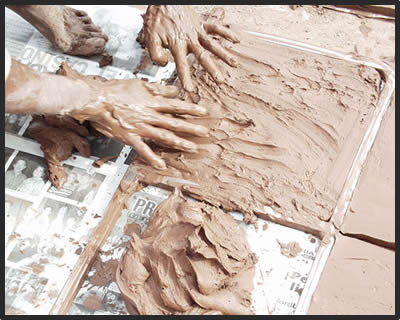 |
To make Saltillo floor tiles the clay is placed in individual wooden molds. |
And an artisan spreads the Saltillo clay with his hands. |
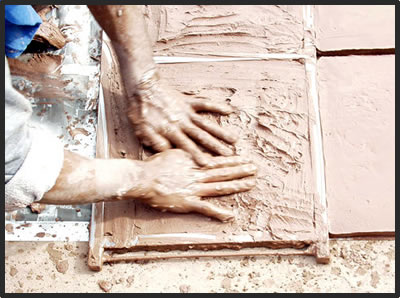 |
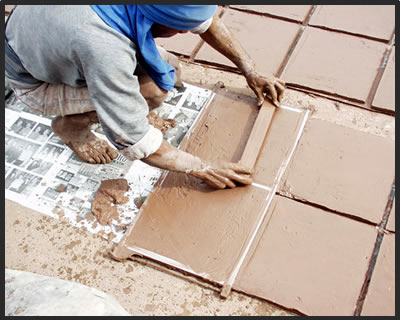 |
The creation of each Mexican handcrafted floor paver involves a laborious process.The artisan makes sure the mold is well covered with an even thickness of clay. |
The artisan smooths the surface of the handcrafted Saltillo floor terra cotta tile with a piece of wood. |
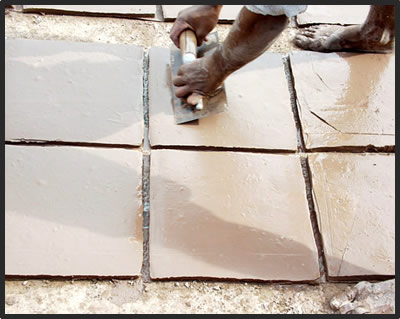 |
 |
Artisans smooth the surface of each handcrafted Saltillo floor tile some more. |
Rows of Saltillo tile pavers dry up under the sun before they are fired in a kiln. |
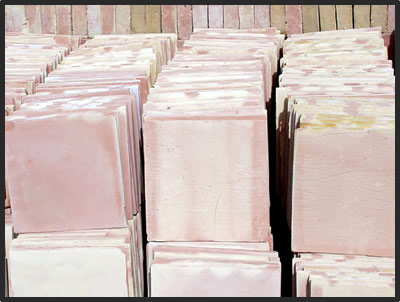 |
|
Mexican handcrafted floor pavers are piled after they are fired, before they are packed to be shipped. Look for the ocassional bird or coyote footprints marks on handcrafted floor tiles. The variations in shades and colors are unique charateristics of handmade tiles. Handcrafted floor tiles bring warmth and interest to any environment. |
11.5" x 11.5" Unsealed Regular Saltillo Square Edges - Floor Tile
| Specifications | Description | ||||||||||||||||
|---|---|---|---|---|---|---|---|---|---|---|---|---|---|---|---|---|---|
Recommended Use |      • All residential and medium use industrial flooring. • Tiles are Not Frost Resistant. Outdoor use in areas where freezing temperatures are not common. • Moist areas where tiles are not submerged in water. • Tiles and grout must be sealed with a penetrating sealer that will form an invisible barrier resistant to moisture and stains. | ||||||||||||||||
|
Recommended Rooms |     • Outdoor use is subject to climate conditions and method of installation. • Not recommended on outdoor installations with potential freezing temperatures. | ||||||||||||||||
| Specifications |
| ||||||||||||||||
| Regular vs. Super | • Super Saltillo tiles are distinguished for their rounded edges in comparison to regular Saltillo tiles which have squared edges.
| ||||||||||||||||
| Tiles per Square foot |
Please Note: Customer is responsible for final quantity order.
| ||||||||||||||||
| Care and Considerations | • Clean with mild cleanser and damp cloth, do not use abrasive cleaners. • Unique, irregular, functional and expressive. Saltillo tiles vary in texture, they have chipped edges, craters, and from time to time you may run into tiles with animal tracks. A high percentage of the batches of Saltillo tiles are subject to "lime pops". Craters or lime pops are caused by alkaline deposits, these are usually inhibited and may be stopped by sealing the tile with a penetrating sealer. Sealers penetrate into the lime pocket, demystifying it, keeping water out and therefore preventing the lime pop.
| ||||||||||||||||
| Installation | • For Installation Recommendations refer to our Installation Guide
| ||||||||||||||||
| Qualities |  |
Frequently Bought Together:
-
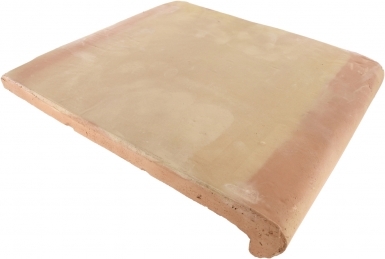 11.5" Unsealed Stair Tread Super Saltillo - Floor Tile
$8.50Item# 30036Quick Shop
11.5" Unsealed Stair Tread Super Saltillo - Floor Tile
$8.50Item# 30036Quick Shop -
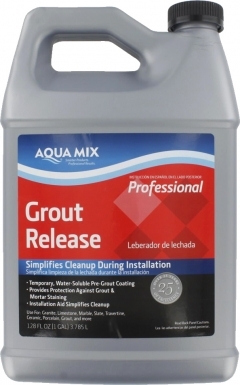 Aqua Mix Grout Release
$10.49 - $19.16Item# 99944Quick Shop
Aqua Mix Grout Release
$10.49 - $19.16Item# 99944Quick Shop -
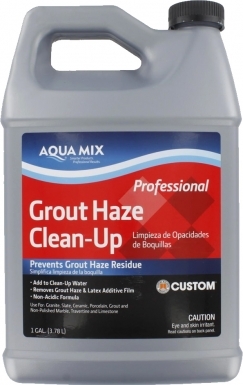 Aqua Mix Grout Haze Clean-Up
$8.35 - $35.65Item# 99945Quick Shop
Aqua Mix Grout Haze Clean-Up
$8.35 - $35.65Item# 99945Quick Shop